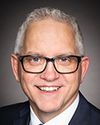Thank you.
Hello. Aaniin. My name is Clio Straram. I am Cree, and my community is Fond Du Lac first nation. I am the head of indigenous banking at the Bank of Montreal.
BMO has a long history of partnering with indigenous communities. The indigenous banking unit, which I head up, was created in 1992—that's 30 years ago today—to address a gap in available capital for first nations governments as a result of the Indian Act.
A housing shortage has existed for indigenous people for generations. Due to the Indian Act, banks cannot take security over tangible assets on reserve. Anyone who is not a member of the community is not allowed to seize ownership of assets on reserve. For this reason, for generations indigenous peoples have not been able to build needed infrastructure in their communities, or even build intergenerational wealth for themselves and their families, the way that Canadians have off reserve. Homes also create a place to heal from intergenerational trauma.
In response to this, we figured out how to lend in this space by relying on the strength of the first nations or indigenous governments and their guarantees. In 1995 our on-reserve home loan program was created to make it possible for indigenous peoples living on reserve to borrow from a major financial institution to buy, build or renovate a home in their community.
In addition to our on-reserve home loan program, BMO has partnered with the first nations market housing fund. The fund provides additional security in the form of a credit enhancement. We do section 10 and section 95 loans, lending to indigenous governments and people to build homes. These loans are supported by ministerial guarantees and CMHC insurance.
We also provide infrastructure loans to indigenous governments to build multiple homes. This can be done without a ministerial guarantee or CMHC insurance, but is instead based on the strength of the indigenous government. These homes can be either rented or sold to members after they're built. This approach reduces the cost to build each home as economies of scales are achieved, which is particularly important for some of our more northern and remote communities.
While these products alone will not solve the housing shortages, they represent BMO's commitment to making a positive difference. However, there are many factors at play. Household incomes are also a critical component. As a result, as a response to the Truth and Reconciliation Commission's call to action for corporate Canada, BMO's indigenous strategic framework is based on three pillars—education, employment and economic empowerment. These are guided by our indigenous advisory council. Higher education and employment opportunities lead to higher incomes.
In response to this, at BMO we support indigenous students with scholarships and bursaries. We also strive to increase our indigenous representation at BMO through internships, hiring programs and formal mentoring programs for our new hires to support them during their career at BMO.
We are also a member of Canadian Council for Aboriginal Business, and were awarded with a progressive aboriginal relations award at the gold level consecutively six times. This award measures companies' indigenous employment and procurement practices. The gold level is the highest-possible achievement.
Looking ahead, there's still much that can be done. It's critically important to increase the available supply of housing in indigenous communities. Additionally, these homes need to be equipped to handle the impacts of climate change, heat waves, forest fires, extended freezing temperatures and flooding. These are all realities that will only worsen. Our northern communities are particularly feeling these extremes, exacerbated by the higher building and energy costs.
Creating stronger, adaptable, mobile and energy-efficient homes will be key. Partnerships, I believe, will also contribute to making positive change possible.
Meegwetch.




